1.
Which of the following subjects is/are considered as applied science?
I. Biology
II. Medicine
III. Psychology
I and II only
I and III only
II and III only
I, II and III
2.
Which of the following step(s) is/are required in the scientific method?
I. Formulation of hypothesis
II. Identification of the problem
III. Experimentation
I only
II only
II and III only
I, II and III
3.
Brass is an alloy of
iron and carbon
zinc and copper
iron and copper
copper and tin
4.
The space occupied by matter is its
area
length
volume
width
5.
The process by which a naphthalene ball (camphor) placed in a box gets smaller in size is termed
Melting
Condensation
Evaporation
Sublimation
6.
What is the average body temperature of a healthy person?
25°C
36°C
37°C
38°C
7.
The volume of a metal ball was determined by dropping it into a measuring cylinder containing 20 cm3 of water and the water level rose to 35 cm3. If the mass of the ball is 35 g, calculate its density.
1.0 g cm-3
1.6 g cm-3
1.8 g cm-3
2.3 g cm-3
8.
Which of the following is the organic part of the soil?
Mineral salts
Water
Humus
Air
9.
Which of the following arrangements is the correct order of increasing complexity of the structure?
Cells → systems → tissues → organs
Cells → tissues → systems → organs
Cells → organs → tissues → systems
Cells → tissues → organs → systems
10.
Soil aeration can be improved by
Adding mineral to the soil
Application of fertilizer to the soil
Manuring
Activities of earthworms
11.
Substances that burn living tissues when they come into contact with these tissues are considered
Corrosive
Flammable
Irrirant
Toxic
12.
A substance is termed combustible if it
easily catches fire.
dissolve common salt.
sublimes at room temperature.
boils at 100oC.
13.
Which of the following is cultivated on plantation basis?
Okro
Tomato
Rubber
Cassava
14.
All the following add nitrates to the soil except
Okro
Broad beans
French beans
Groundnuts
15.
Fertilized ovules develop into
fruits
cotyledon
plumule
seeds
16.
The carpel of a flower is made up of the following parts except
filament.
ovary.
style.
stigma.
17.
Dehusking and shelling are both activities carried out in the processing of
cowpea.
groundnut.
maize.
sorghum.
18.
Transplanting of seedlings is usually done in the evening because
darkness promotes rapid growth
pest attack is minimal.
transpiration is minimal.
seedlings require less nutrients.
19.
The figure below is a diagram of a fish.
Use it to answer Questions 19 and 20.

The function of the part labelled IV is to enable the fish to
sink in water.
absorb oxygen from the water.
protect itself from attack.
detect smell in water.
20.
The part labelled V is used for
balancing.
steering.
surfacing.
paddling.
21.
Which of the following is the percentage composition of oxygen in the air?
0.03
1
21
78
22.
Which of the following are products of respiration?
Glucose and oxygen
Waste food, energy and carbon dioxide
Energy, carbon dioxide and water
Energy, oxygen and water
23.
Legumes are generally included in crop rotation because they
are easy to uproot in preparation for the next planting season.
are able to fix atmospheric nitrogen in the soil.
have short life span.
are good cover crops.
24.
The farming system which involves the growing of one type of crop on the same piece of land every season is known as
mixed cropping.
mixed farming.
monocropping.
monoculture.
25.
Energy is measured in
Kelvin
Joules
Watts
Metres
26.
The source of all forms of energy can be traced to
clouds.
earthquakes.
tides.
sunlight.
27.
The law of conservation of energy states that energy can
be created but not transformed
be destroyed but not transformed
neither be created nor transformed
neither be created nor destroyed, but only be transformed
28.
A body of mass 50 kg falls through a height of 5 m. If the acceleration due to gravity is 10 ms-2, calculate the loss in potential energy.
50 J
250 J
500 J
2500 J
29.
In which of the positions Q,R,S,T in the diagram below will a body have the greatest potential energy?
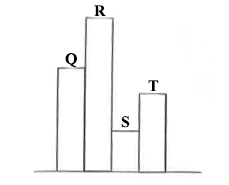
Q
R
S
T
30.
The diagram below represents a circuit symbol in an electronic device.
Study it carefully and use it to answer Questions 30 and 31.
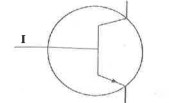
The symbol represents
a light emitting diode.
n-p-n transistor.
light dependent resistor.
p-n-p transistor.
31.
The part of the diagram labelled I has
more electrons than holes.
no holes.
more holes than electrons.
the same number of holes as electrons.
32.
A ray of light makes an angle of 20o with the surface of a plane mirror. Determine the angle of reflection.
20o
50o
70o
90o
33.
Which of the following arrangements is a probable food chain.
Grass → Grasshopper → Toad → Snake → Crow
Grasshopper → Grass → Goad → Lion → Man
Crow → Snake → Toad → Grasshopper → Grass
Grass → Goat → Lion → Man → Snake
34.
An atom of carbon is represented as 612 C. How many neutrons are in the nucleus of the carbon atom?
2
4
6
12
35.
An atom has 6 protons and 7 neutrons in its nucleus. What is the mass number?
1
6
7
13
36.
The temperature of 20oC on the kelvin scale is
253 K.
263 K.
273 K.
293 K.
37.
What is the work done when a force of 2.5 N moves through a distance of 4 m?
0.6 J
1.5 J
6.5 J
38.
Which of the following processes is a physical change?
Rusting of iron
Burning of paper
Melting of ice
Fermentation of palm wine
39.
67%
40%
33%
30%
40.
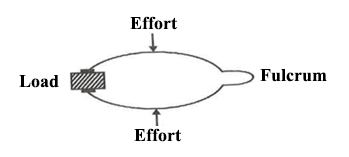
The type of lever shown above is a
first class lever.
second class lever.
third class lever.
combination of first and second class levers.
[1 hours]
This paper is in two sections: A and B. Answer Question 1 in section A and any other four questions in section B.
Answer all the questions in your answer booklet.
Credit will be given for clarity of expression and orderly presentation of material.
Answer all of Question 1.
(a)
The diagram below is a structure in mammals.
Study it carefully and answer the questions that follow.
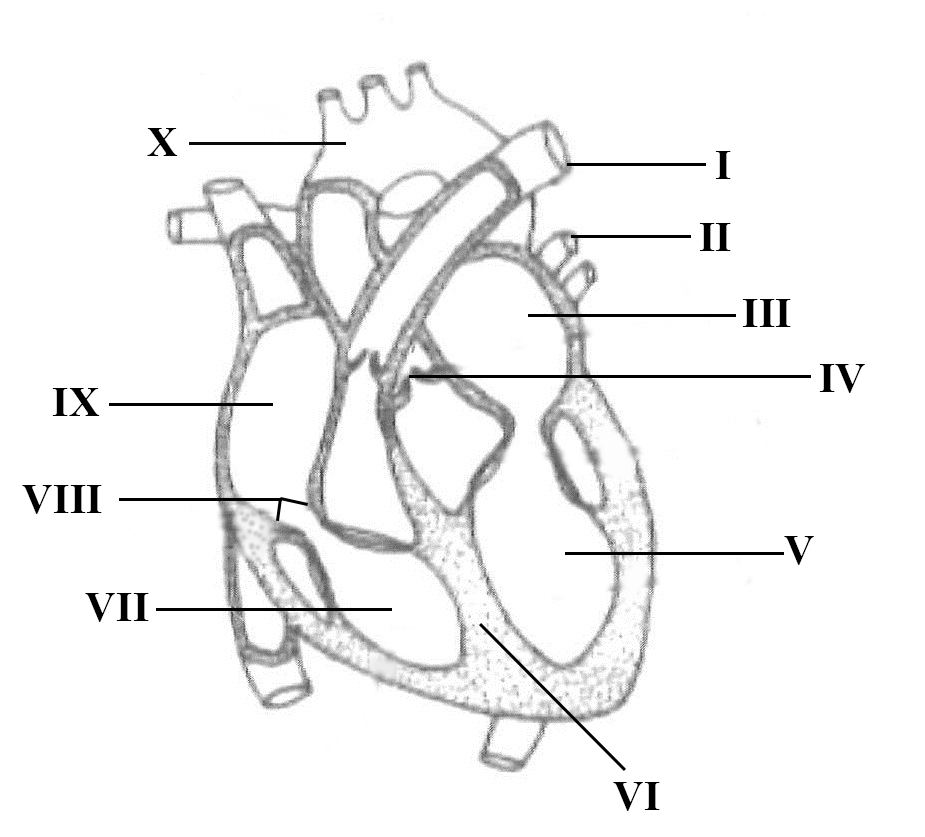
(i)
Identify the structure above.
(ii)
State the location and function of the structure above.
(iii)
Name each of the parts labelled I, II, III, IV, V, VI, VII, VIII, IX and X
(iv)
State the function of each of the parts labelled I, II, III, IV, V, VI, VII, VIII, IX and X
(v)
The muscular wall of chamber V is at least three times ticker than the wall of chamber VII. Give a reason for this difference.
(b)
The diagram below shows the three main blood vessels.
Study it carefully and answer the questions that follow.
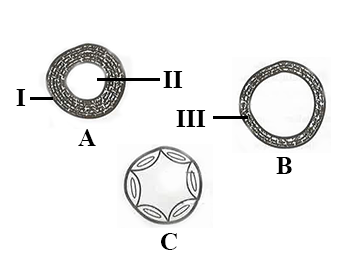
(i)
Identify each of the blood vessels labelled A, B and C.
(ii)
Identify the parts labelled I, II and III.
(iii)
State the function of each of the blood vessels identified in (i).
(iv)
State two differences between each of the blood vessels identified in (i).
(c)
A rigid bar of length 100 cm is used to lift a block as shown below.

(i)
Name the parts labelled I, II and III when it is considered as a lever.
(ii)
What class of lever is shown above?
(iii)
Give two examples of machines used in everyday life which work on the same principle as the system illustrated above.
(iv)
Calculate the II distance.
(v)
Calculate the mechanical advantage of the rigid bar.
(d)
The following activities were carried out in the laboratory.
Study them carefully and answer the questions that follow.
| I. | An object is placed in front of a pinhole camera |
| II. | Two candles is lighted simultaneously and a glass jar is mounted on one of the two candles |
| III. | Air is breathed into a test tube containing limewater fitted with a delivery tube |
| IV. | Few drops of iodine solution is added to starch |
| V. | A drop of fat is applied to a white sheet of paper |
| VI. | Benedict's solution is added to a food substance, the mixture boiled and the Benedict's solution turns from blue to brick-red |
| VII. | Ammonium chloride and calcium hydroxide is heated |
| VIII. | Both red and blue litmus papers were dipped each in Hydrochloric acid, Sodium hydroxide and water |
(i)
State what will be observed in each of the activities I, II, III, IV, V, VII and VIII
(ii)
State the aim of the experiment for each of the activities II and III
(iii)
What food substance was tested in activity VI?
Answer four questions only from this section.
(a)
(i)
In what two ways does mulching help to conserve the soil?
(ii)
Give two examples of mulching materials.
(b)
(i)
What is pollution?
(ii)
List three major atmospheric pollutants.
(c)
(i)
State two ways in which legumes are important in crop production.
(ii)
State three advantages of crop rotation.
(d)
(i)
State three qualitites of a good thermometric liquid.
(ii)
Give two precautions that must be taken when using a liquid-in-glass thermometer.
a)
i)
What is rusting?
ii)
List two methods of preventing rusting.
b)
State three ways of controlling pests on a maize farm.
c)
i)
Name three structures in the middle ear that help in the transmission of sound waves;
ii)
Mention two ways in which earmuffs are important.
d)
i)
Arrange the following stages of water treatment for public consumption in the correct order:
chlorination, sedimentation, screening, sand filtration and aeration.
ii)
State the significance of each of the following stages in water treatment:
α)
screening;
β)
filtration;
γ)
chlorination
a)
State five post planting practices on cereal farm to ensure a high yield.
b)
i)
Define each of the following:
α)
a machine;
β)
mechanical advantage of a simple machine;
γ)
velocity ratio of a machine.
ii)
An amount of 300.0 J of work is done when a force moves through a distance of 10.0 m in the direction of the force.
Calculate:
α)
the force;
β)
the mass of the body.
[Take g = 10 ms-2]
c)
i)
State two differences between hypogeal germination and epigeal germination.
ii)
Give one example of seeds that undergo:
α)
hypogeal germination;
β)
epigeal germination.
d)
i)
Define resistance of a conductor.
ii)
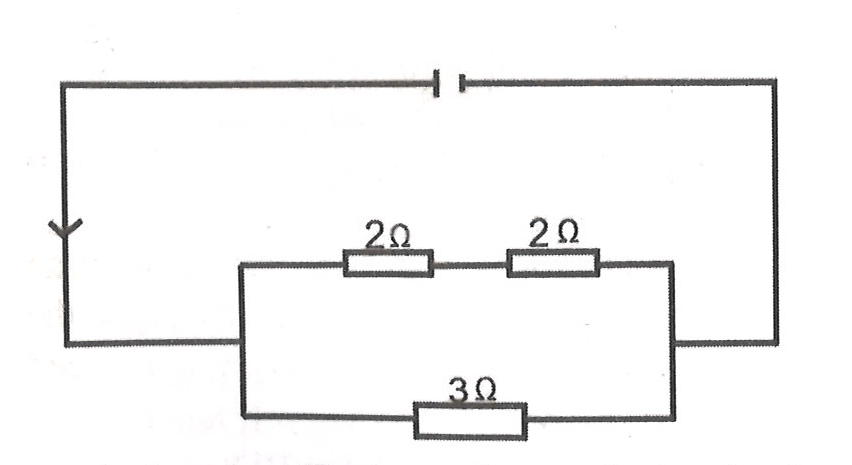
Calculate the effective resistance in the circuit
a)
i)
State two differences between compounds and mixtures.
ii)
State three ways through which AIDS is transmitted.
b)
i)
What is a shadow?
ii)
Name the types of shadows.
iii)
Draw and label a diagram to show the formation of shadows from a point source of light.
c)
i)
What is a reflex action?
ii)
Classify the following actions as voluntary or involuntary actions:
α)
Laughing;
β)
Blinking of the eyes;
γ)
Sneezing;
θ)
Eating;
ω)
Walking.
iii)
Name the sense organs and state one function of each.
d)
i)
What is a hormone?
ii)
Copy and complete the following table
| Name of hormone | Organ secreting hormone | Function of hormone |
| Adrenalin | ||
| Thyroxin | ||
| Insulin |
a)
i)
Explain the term convection as used in heat energy.
ii)
Explain why convection cannot take place in solids.
b)
The following table gives information about some elements.
Study the table carefully and answer the questions that follow.
| Element | Number of Protons | Number of Neutrons | Number of Electrons |
| A | 8 | 8 | 10 |
| B | 17 | 18 | 18 |
| C | 12 | 12 | 10 |
| D | 11 | 12 | 10 |
| E | 17 | 20 | 17 |
i)
Which of the element(s) is/are positive ion(s)?
ii)
Which of the element(s) is/are negative ion(s)?
iii)
Which of the element(s) form(s) isotopes?
c)
i)
Tabulate two differences between red blood cells and white blood cells.
ii)
State the expected changes that will occur in the composition of the blood leaving a muscle of a person soon after a period of vigorous activity.
d)
i)
Explain each of the following terms:
α)
soft water;
β)
hard water.
ii)
State two methods of softening hard water.
iii)
α)
Write a balanced chemical equation to show how water is formed
β)
State two physical properties of water.